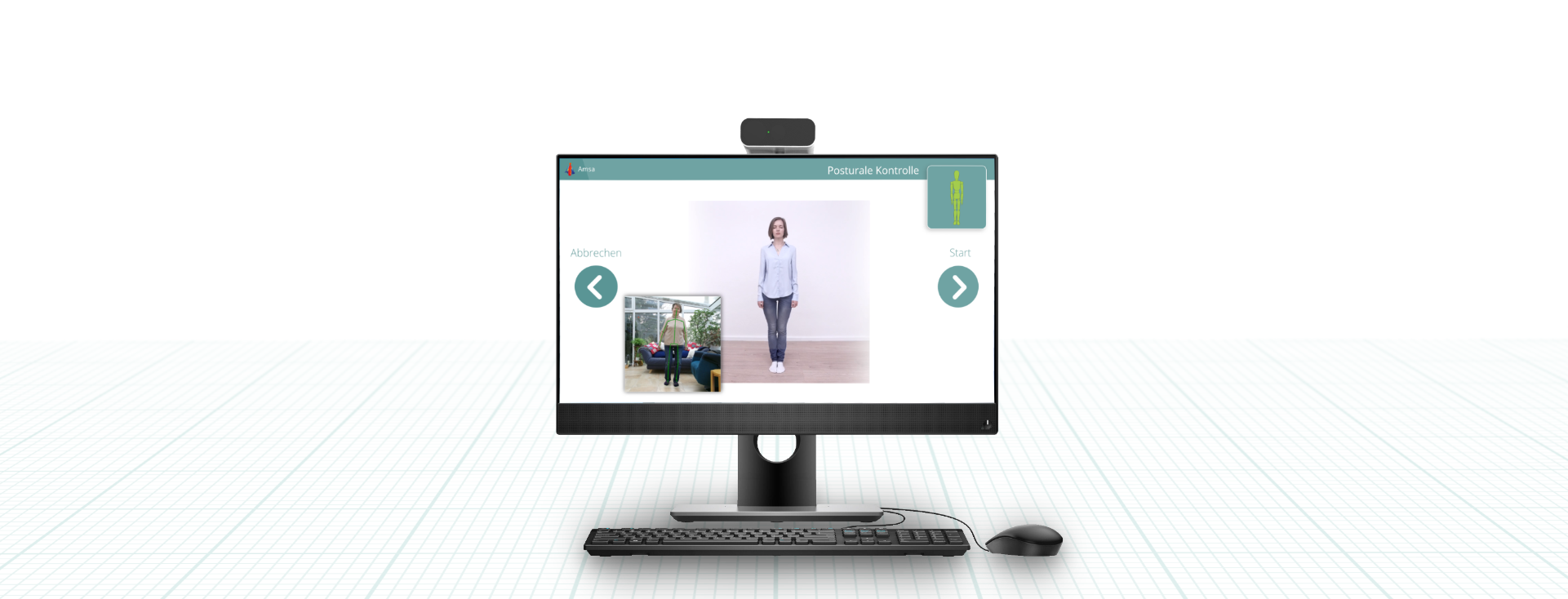
Motion analysis can improve the life of patients, families and caregivers, and enable healthcare professionals to improve treatment outcomes. Working closely with medical experts, we identify and extract clinically relevant parameters from 3D camera recordings and provide a powerful solution to track motoric symptoms. This enables in-depth motor symptom analysis in many previously inaccessible in-patient, outpatient and at-home settings.
Amsa as a digital health application
Motognosis Amsa is a certified medical software to measure motor tasks. By performing a short, adaptable test set, the software generates kinematic parameters (like gait speed) to describe motor symptoms.
All kinematic parameters were technically and clinically validated in studies at Charité university hospital Berlin, the largest university clinic in Germany. The tests only take 10-15 minutes per session and provide enough information to monitor symptoms for people with Parkinson’s Disease.

How Amsa works
The user performs a sequence of movement tasks that are shown on screen, which is developed to uncover specific motor dysfunction.


During the tasks, full body movement data is recorded in 3D and then analyzed on device.
The result is a comprehensive report of motor impairment of the patient, summarized in a dashboard showing changes over time. Sensitive symptom parameters enable adjustment of therapy or medication by the treating healthcare professional.


Learn more about our technology
Why you should use Amsa
Clinically relevant symptoms can be assessed from the comfort of your home.
Amsa automatically detects and quantifies symptom parameters during the execution of 3 to 5 short motion tasks (max. 1 min each) which can be done at home. The clinically relevant symptoms can be reviewed in a comprehensive motor function report, enabling therapists and neurologists to make better and faster treatment decisions.
How to use Amsa
After installing Amsa in your home, you can use Amsa directly with the help of the 3D camera set up by Motognosis GmbH. All described contents of Amsa are directly activated for you and there are no additional costs. Additional costs may be incurred when transferring data via the Internet.
When using Amsa some criteria have to be considered, where the use of Amsa is not recommended by Motognosis GmbH. Amsa is not suitable for patients if severe skeletal or tissue malformations are present, the body height is below 150cm or the BMI is above 30. Likewise, there are contraindications in the case of advanced dementia or cognitive impairment that does not allow the operation of Amsa, or a high risk of falling.
The German user manual can be found here.
Pricing
All relevant information regarding our pricing of Amsa can be found in DiGa Verzeichnis of BfArM: diga.bfarm.de
Technical information
Data protection
The Amsa software has been developed with data protection requirements of medical and personal data in mind. Only data that is necessary for the use of the system and reports generated from it is collected. The principle of data economy and purpose limitation is therefore taken into account.
The software has no direct interface and does not allow direct transfer or retrieval of medical data. All collected sensitive data is stored pseudonymously in password-protected data containers.
Data processing is performed on the local terminals. Access to the software and data is secured via the Windows 10 login mechanism; a firewall is configured.
The software and its configuration are encrypted.
Prior to the use of Amsa, the presence of a signed DSGVO-compliant privacy policy of all patients is required.
Interoperability standard

Amsa has no direct interfaces to other medical devices, but supports data export according to FHIR standard v4.0.1.
Compatibility
Amsa can be installed on any computer or tablet that meets Amsa’s hardware and software requirements. The software uses commercially available 3D cameras from Microsoft. Currently, the following 3D cameras are supported: Microsoft Kinect for Xbox One (model 1520, v2), Azure Kinect (model 1880, v4).
The minimum requirements for Amsa are:
- Operating system: Windows 10
- CPU: Intel Core i7 8th Generation (4 physical cores)
- Ram: 16GB DDR3
- Hard disk: SSD 512 GB, with additional 2 TB HDD
- Graphics Card: NVIDIA GeForce GTX 1050
- USB: Intel USB 3.0 eXtensible Host Controller
If you have questions or need further support, please contact us via contact@motognosis.com
Publications, conference posters and studies
For more information about our publications click here. For more information about our studies click here.
Foundational medical research
-
Achey M, Aldred JL, Aljehani N, Bloem BR, Biglan KM, Chan P, Cubo E, Dorsey ER et al. International Parkinson and Movement Disorder Society Telemedicine Task Force. The past, present, and future of telemedicine for Parkinson’s disease. Mov Disord. 2014 Jun;29(7):871-83. doi: 10.1002/mds.25903. Epub 2014 May 17. PMID: 24838316.
-
Chahine LM, Siderowf A, Barnes J, Seedorff N, Caspell-Garcia C, Simuni T et al. The Parkinson’s Progression Markers Initiative. Predicting Progression in Parkinson’s Disease Using Baseline and 1-Year Change Measures. J Parkinsons Dis. 2019;9(4):665-679. doi: 10.3233/JPD-181518. PMID: 31450510; PMCID: PMC6839498.
-
Deutsche Gesellschaft für Neurologie. S3 Leitlinie Idiopathisches Parkinson-Syndrom. AWWF register number: 030 - 010
-
Dorsey ER, George BP, Leff B, Willis AW. The coming crisis: obtaining care for the growing burden of neurodegenerative conditions. Neurology. 2013 May 21;80(21):1989-96. doi: 10.1212/WNL.0b013e318293e2ce. Epub 2013 Apr 24. PMID: 23616157; PMCID: PMC3716348.
-
Eggers C, Wellach I, Groppa S, Strothjohann M, Klucken J. Versorgung von Parkinson-Patienten in Deutschland: Status quo und Perspektiven im Spiegel des digitalen Wandels. Nervenarzt. 2020 Nov 16:1–8. German. doi: 10.1007/s00115-020-01027-3. Epub ahead of print. PMID: 33196867; PMCID: PMC7667482.
-
Espay AJ, Bonato P, Nahab FB, Maetzler W, Dean JM, Klucken J, Hausdorff JM, Bloem BR, Papapetropoulos S et al. Movement Disorders Society Task Force on Technology. Technology in Parkinson’s disease: Challenges and opportunities. Mov Disord. 2016 Sep;31(9):1272-82. doi: 10.1002/mds.26642. Epub 2016 Apr 29. PMID: 27125836; PMCID: PMC5014594.
-
Gerlach OH, Winogrodzka A, Weber WE. Clinical problems in the hospitalized Parkinson’s disease patient: systematic review. Mov Disord. 2011 Feb 1;26(2):197-208. doi: 10.1002/mds.23449. Epub 2011 Jan 31. PMID: 21284037; PMCID: PMC3130138.
-
Heinzel S, Berg D, Binder S, Ebersbach G, Hickstein L, Herbst H, Lorrain M, Wellach I, Maetzler W, , Amelung V. et al. Do We Need to Rethink the Epidemiology and Healthcare Utilization of Parkinson’s Disease in Germany? Front Neurol. 2018 Jun 29;9:500. doi: 10.3389/fneur.2018.00500. PMID: 30008693; PMCID: PMC6033992.
-
Heldman DA, Harris DA, Felong T, Andrzejewski KL, Dorsey ER, Giuffrida JP, et al. Telehealth Management of Parkinson’s Disease Using Wearable Sensors: An Exploratory Study. Digital biomarkers. 2017;1(1):43-51. Marinus J, Ramaker C, van Hilten JJ, Stiggelbout AM. Health related quality of life in Parkinson’s disease: a systematic review of disease specifc instruments. J Neurol Neurosurg Psychiatry. 2002 Feb;72(2):241-8. doi: 10.1136/jnnp.72.2.241. PMID: 11796776; PMCID: PMC1737742.
-
Odin P, Chaudhuri KR, Volkmann J, Antonini A, Storch A, Bergquist F et al. Viewpoint and practical recommendations from a movement disorder specialist panel on objective measurement in the clinical management of Parkinson’s disease. NPJ Parkinsons Dis. 2018 May 10;4:14. doi: 10.1038/s41531-018-0051-7. PMID: 29761156; PMCID: PMC5945844.
-
Rovini E, Maremmani C, Cavallo F. How Wearable Sensors Can Support Parkinson’s Disease Diagnosis and Treatment: A Systematic Review. Front Neurosci. 2017 Oct 6;11:555.
-
Spottke AE, Reuter M, Machat O, Bornschein B, von Campenhausen S, Berger K, Koehne-Volland R, Rieke J, Simonow A, Brandstaedter D, Siebert U, Oertel WH, Ulm G, Dodel R. Cost of illness and its predictors for Parkinson’s disease in Germany. Pharmacoeconomics. 2005;23(8):817-36. doi: 10.2165/00019053-200523080-00007. PMID: 16097843.
-
Stangl S, Haas K, Eggers C, Reese JP, Tönges L, Volkmann J. Care of patients with Parkinson’s disease in Germany. Der Nervenarzt. 2020;91(6):493-502.
-
Willis AW, Schootman M, Evanoff BA, Perlmutter JS, Racette BA. Neurologist care in Parkinson disease: a utilization, outcomes, and survival study. Neurology. 2011 Aug 30;77(9):851-7. doi:10.1212/ WNL.0b013e31822c9123. Epub 2011 Aug 10. PMID: 21832214; PMCID: PMC3162639.
If you have questions regarding study participation or Amsa purchasing options, please contact us at contact@motognosis.com